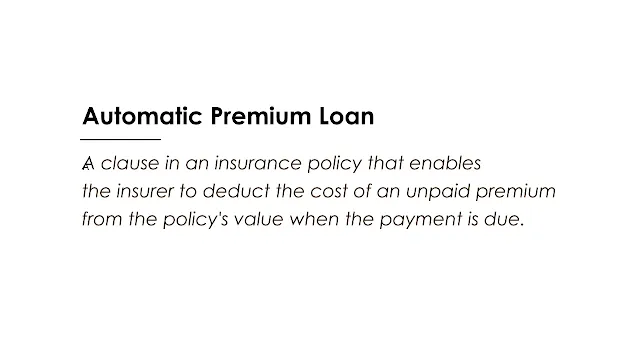 |
| Image: Moneybestpal.com |
An automated premium loan (APL) is a clause in an insurance policy that enables the insurer to deduct the cost of an unpaid premium from the policy's value when the payment is due. Automatic premium loan clauses are most frequently seen in cash-value life insurance plans, such as whole life because they allow a policy to remain in existence rather than expire for lack of premium payment.
A type of permanent life insurance called cash-value life insurance offers both a death payout and a savings element. The savings component also referred to as the cash value, builds up over time as an amount of the premiums paid by the policyholder is invested by the insurer. The policyholder has three options for getting access to the cash value: withdrawals, loans, and policy surrender.
An automatic premium loan does have an interest rate because it is essentially borrowing against the policy's cash value. For personal loans, the interest rate is typically lower than the market rate, but greater than the rate that the cash value earns. It's possible that the insurance policy's cash value will drop to zero if the policyholder keeps paying the premium using this approach. Since there is nothing left to offer as collateral for a loan at this point, the policy will expire. When a policy is canceled with an outstanding loan, the cash value of the policy is reduced before it is canceled by the amount of the loan and any applicable interest.
An automatic premium loan is meant to prevent a policy from lapsing, which would end coverage and may result in tax repercussions. When a policyholder fails to pay the premium during the grace period, which is typically 30 or 31 days after the due date, the insurance lapses. A lapsed policy may be renewed within a specific timeframe, often two to five years, but may also call for proof of insurability and payment of past-due premiums plus interest.
The policyholder may activate or deactivate an automatic premium loan at any time. The policyholder must submit a written request to some insurers in order to activate or deactivate the provision, while other insurers may provide online choices. The debt can also be repaid in full or in part whenever the policyholder wants, or they can let it accumulate until they die or surrender.
- It offers a simple, automatic way to pay past-due premiums and keep your policy active.
- The loan is secured by the cash value of the insurance policy, therefore neither a credit check nor collateral are needed.
- Since the loan is not recorded to credit bureaus, it has no impact on the policyholder's credit rating or credit report.
- As long as the loan amount does not exceed the policy's cost basis, it is exempt from taxes and penalties.
- The loan amount plus interest is subtracted from the policy's cash value and death payout.
- When the cash value is insufficient to pay for future premiums, the likelihood that the insurance may lapse rises.
- If the policy expires or is surrendered with an outstanding loan that is greater than the cost basis of the policy, it can constitute a taxable event.
- The eligibility for dividends or other benefits based on the cash value of the policy may be diminished or eliminated.
Consider the following example to see how an automatic premium loan functions. Consider John, who has a whole life insurance policy with a $10,000 cash value and a face value of $100,000. The $1,000 annual premium is due on January 1st of each year, and he pays it. His policy's cash value accrues interest at a rate of 4%, while the interest on his automatic premium loan is 6%.
John failed to pay his insurance payment on January 1st, 2023. His insurance company turns on the automatic premium loan feature and deducts $1,000 from the cash value of the policy to cover the past-due premium. He is now worth $9,000 in cash.
John continues to not pay his premium as of January 1st, 2024. His insurer takes another $1,000 out of his cash value to cover the unpaid premium by using the automated premium loan provision. His current market value is $8,000 in cash.
John eventually paid his $1,000 premium on January 1st, 2025. His current cash value is $9,000, but his insurer still owes him $2,000 plus interest. The interest on his loan is calculated as follows:
Interest for 2023 = $1,000 x 6% x 1 = $60
Interest for 2024 = ($1,000 + $60) x 6% x 1 = $63.60
Total interest = $60 + $63.60 = $123.60
Now, he owes $2,123.60 on his entire loan. He can opt to pay back this sum in full or in part, or he can let it amass until his demise or surrender.
The death benefit of $100,000 less the loan balance of $2,123.60, or $97,876.40, will be paid to John's beneficiaries if he passes away in 2025.
John will earn $6,876.40 if he surrenders his policy in 2025. This is the cash value of his policy, which is $9,000, less the loan debt of $2,123.60.
The automatic premium loan is a feature that enables a policyholder to use the cash worth of their life insurance policy to pay past-due payments and prevent a policy lapse. Before employing it, the advantages and disadvantages should be thoroughly considered. This idea and its consequences for risk management and insurance should be understood by MBA students.
